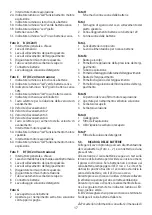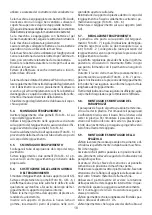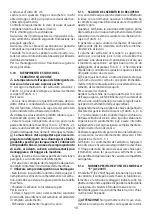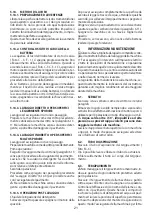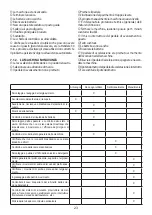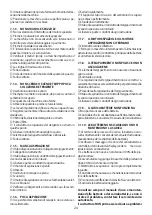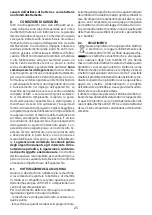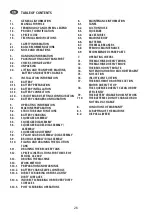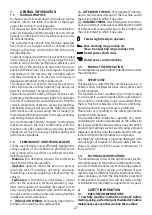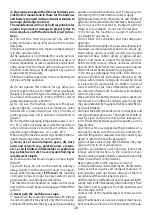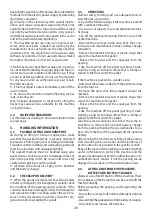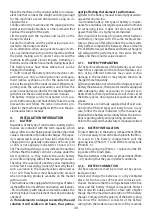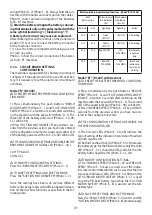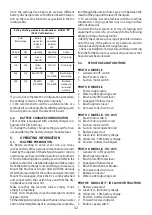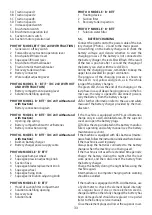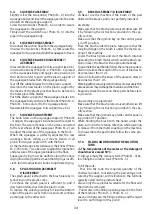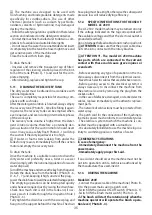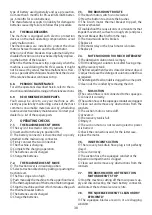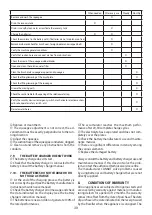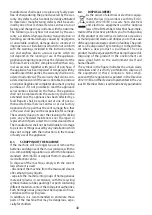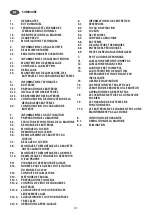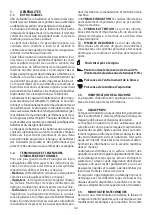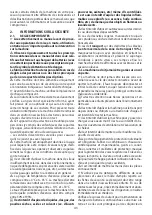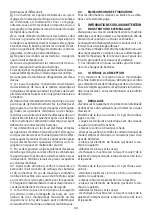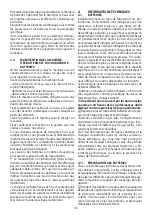
30
Place the machine on the original pallet (or an equiv-
alent one that can bear the weight and is big enough
for the machine’s overall dimensions) using an in-
clined surface.
Solidly anchor the machine and the squeegee to the
pallet using metallic brackets or other elements that
can bear the weight of the parts.
Lift the pallet with the machine and load it on the
transport vehicle.
Secure the machine and the pallet using ropes con-
nected to the transport vehicle.
As an alternative, when using private transport vehi-
cles, use inclined ramps to push the machine without
the pallet, making sure to protect all parts and the
machine itself against violent impacts, humidity, vi-
brations and accidental movements during transport.
The battery boxes have holes where tools can be
hooked for handling.
☞
To lift or insert the battery (into the machine com-
partment), use only suitable personnel and equip-
ment (cables, eyehooks, etc.) for the operation and
to bear the weight of the loads involved. When trans-
porting, take the same precautions and follow the
same instructions provided for the machine together
with those in the special manufacturer’s manual.
The battery charger can be transported on its sup-
ports, both vertically and horizontally. Take the same
precautions and follow the same instructions pro-
vided for the machine together with those in the spe-
cial manufacturer’s manual.
4.
INSTALLATION INFORMATION
4.1.
BATTERY
Regardless of the type of construction, battery perfor-
mances are indicated with the term capacity, which
always refers to a discharge period. Another important
value is the number of possible discharges. The capac-
ity is expressed in amps per hour (Ah), while the dis-
charge period is generally indicated as 20 hours (C20
or 20h, or not expressly indicated) or 5 hours (C5 or
5h). The discharge/charge cycles indicate the number
of times that the battery can hold a charge under the
best conditions, i.e. they indicate the useful battery
service life complying with all the necessary measures.
Therefore, the capacity of a battery varies depending
on how fast it uses energy (current). That’s why there’s
such a variation in the capacity values expressed as
C5 or C20. These factors must be taken into account
when comparing products available on the market
with our own.
This machine can be equipped with two types of batter-
ies that differ in terms of their construction and features.
- Pb-Acid battery with tubular armored modules: the
electrolyte level in each element must be periodically
checked!
•
If one element is no longer covered by the acid
solution it will oxidize in 24 hours, thus perma-
nently affecting that element’s performance.
•
Refer to the battery manual to avoid physical dam-
age and economic loss.
- Gel module battery: this type of battery is mainte-
nance free and does not require special environments
for recharging (since it does not emit any harmful
gases); therefore, it is highly recommended.
•
It should not be taken for granted that batteries
and battery chargers with the same technical fea-
tures as those we offer will produce the same results.
Only perfect compatibility between these elements
(Pb-Acid batteries, gel batteries and battery chargers)
will safeguard the performances, the service life, the
safety and the economic value invested.
4.1.1. BATTERY PREPARATION
•
The technical features of the batteries used must
match those indicated in the technical features sec-
tion. Using different batteries may cause serious
damage to the machine or may require them to be
charged more frequently.
•
During installation or when performing any type of
battery maintenance, the operator must be equipped
with adequate safety accessories to prevent acci-
dents. Work far from open flames, do not short-circuit
the battery poles, do not generate sparks and do not
smoke.
The batteries are normally supplied full of acid solu-
tion (for the Pb-Acid type) and ready for use. In any
case, follow the steps indicated in the manual sup-
plied with the battery and carefully follow the instruc-
tions regarding safety and operating procedures.
Refer to the relevant manufacturer's manual provided.
4.1.2. BATTERY INSTALLATION
To insert batteries in the battery compartment (Photo
I - 2) it is necessary to lower the brush plate to the floor.
To access to the battery compartment, pull the
opening lever (Photo H - 1) and lift the recovery tank
(Photo N - 3).
Detach the spring clip (Photo I - 1) placed on the lift-
ing cable of the brush plate.
Place the batteries in the battery compartment (Photo
I - 2) checking that they are in perfect conditions.
4.1.3. BATTERY CONNECTION
•
These operations must be carried out by special-
ized personnel.
Install and charge the batteries in a dry ventilated
place, far from sources of heat and corrosive sub-
stances. Make sure that the voltage between the bat-
teries and the battery charger corresponds. Protect
the circuit with a delay switch or a fuse with a higher
charge than the maximum absorption of the battery
charger. Comply with the polarity of the battery plug.
Disconnect the Anderson connector of the battery
wiring from the Anderson connector of the machine
Summary of Contents for CPS 50 B
Page 3: ...3 2 1 3 A B 6 1 3 4 5 2 E AC 230V...
Page 4: ...4 C D 2 2A 3A 3B 3C 1A 1 3 6 3 4 5 1 8 2 B DC 24V 7...
Page 6: ...6 H G 1 2 1 3 2 I...
Page 7: ...7 1 2 L M 1 1 4 4 3 2 5 7 6 5 2 6...
Page 8: ...8 N O 1 1 2 3 3 2 4...
Page 9: ...9 P 1...
Page 91: ...91 1 1 1 1 2 2 10 1 3 1 4...
Page 92: ...92 1 5 2 2 1 4 35 10 50 30 95 2 10...
Page 93: ...93 2 2...
Page 94: ...94 3 3 1 3 2 3 3 C C 3 4...
Page 95: ...95 4 4 1 20 20 20h 5 5 5h 5 5 20 20 24 4 1 1 4 1 2 I 2 G 1 3 I 1 I 2...
Page 101: ...101 2 2 2 P 1 5 11 3 1 5 D 6 F 7 3 5 12 AC 230V AC230 AC 230V...
Page 103: ...103 5 14 5 14 1 5 14 2 3 1 3 1 5 14 3 6 13 5 14 4 6 13 6 14 3 5 14 5 6 11 6 6 1 50...
Page 104: ...104 6 2 M 3 6 3 6 4 6 5 6 6 6 7...
Page 105: ...105 6 8 6 8 1 6 8 2 6 8 3 6 9 7 7 1 1 C 7 2 5 7 3...
Page 106: ...106 7 4 7 5 7 6 7 7 7 8 7 9 7 10 100 20 30 8 12...
Page 107: ...107 8 1 2013 56 EU 8 2 2012 19 EU 2012 19 EU...
Page 124: ...124...
Page 125: ...125...
Page 126: ...126...
Page 127: ...127...
Page 128: ...128...
Page 129: ...129...
Page 130: ...130...
Page 131: ...131...
Page 238: ...238 1 1 1 1 2 2 10 1 3 a 1 4...
Page 239: ...239 1 5 2 2 1 4 C 35 C 10 C 50 C 30 95 2 10...
Page 240: ...240 2 2 3 3 1 3 2 3 3...
Page 241: ...241 3 4 4 4 1 Ah 20 C20 20h 5 C5 5h C5 C20...
Page 247: ...247 50 C N 4 N 3 2 N 2 2 L Q 1 5 11 N 3 0 1 B 6 D 6 F 7 0 3 5 12 230V 230V AC 230V...
Page 249: ...249 5 14 2 C 3 E 1 C 3C E 1C 5 14 3 6 13 5 14 4 6 13 6 14 3 5 14 5 6 11 6 6 1 50 6 2 3...
Page 250: ...6 3 250 6 4 6 5 X X X X X X X X X X X X X X X X X X...
Page 251: ...251 6 6 BPb 3 AGM 6 6 7 6 8 6 9 7 7 1 ON 7 2 5 7 3...
Page 252: ...252 7 4 7 5 7 6 7 7 7 8 7 9 7 10 100 20 30 8 12...
Page 253: ...253 8 1 2013 56 8 2 WEEE 2012 19 2012 19 EU...
Page 255: ...255 1 1 1 1 2 2 2 10 1 3 1 4...
Page 256: ...256 1 5 2 2 1 4 C 35 C 10 C 50 C 30 95 2 10...
Page 257: ...257 2 2 134 3 3 1 3 2 3 3...
Page 258: ...258 3 4 4 4 1 4 1 1 Ah 20 C20 20h 5 C5 5h C5 C20...
Page 263: ...263 5 4 M 6 6 M 3 5 5 M 6 5 6 6 5 M 4 M 6 M 4 M 6 6 4 5 7 7 2 45 M 2 M 7 5 8 5 9 1 cm 1 cm...
Page 264: ...264 5 10 50 C N 4 N 3 G 2 N 2 2 cm 5 11 N 3 1 B 6 D 6 F 7 3 5 12 E AC 230V E AC 230V...
Page 267: ...6 2 M 3 6 3 267 X X X X X X X X X X X X X X X X X X...
Page 268: ...268 6 4 6 5 6 6 3 AGM 6 6 7 6 8 6 9 7 7 1 7 1 1 1...
Page 269: ...269 30 7 1 2 5 7 1 3 7 1 4 7 1 5 7 1 6...
Page 270: ...270 7 1 7 7 1 8 7 1 9 7 1 10 100 20 30 8 12 8 1...
Page 271: ...271 2013 56 E 8 2 2012 19 2012 19...


